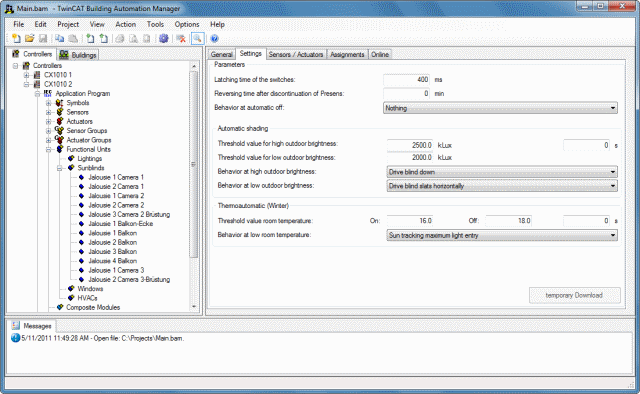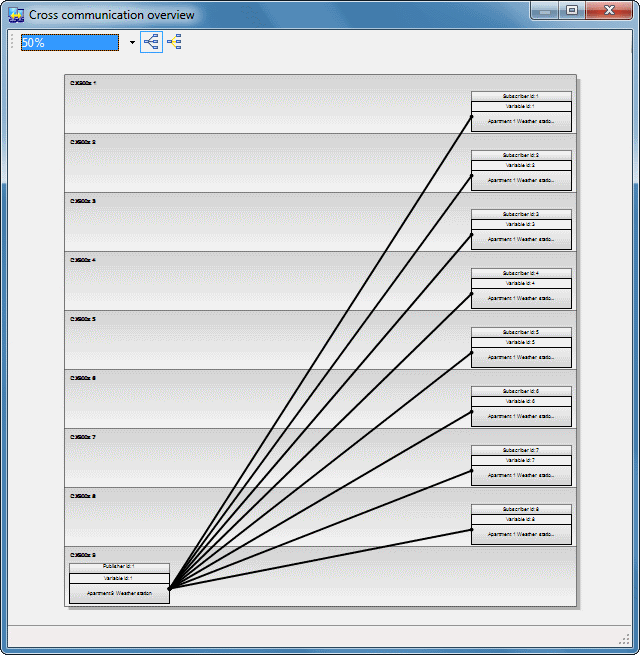Overview
Room automation has gained increasingly in significance in recent years. The term is understood to mean cross-system automation within rooms or, in the case of larger rooms, within zones. Functions from the fields of lighting, air conditioning, sun shading and windows are combined with each other in such a way that an improved energy balance is achieved for the operator. Heating or cooling with open windows or additional lighting when there is sufficient daylight worsen the energy efficiency. Particularly large potential is offered by intelligent façade control, for example. Hence, sun blinds can be retracted on sunny winter days at the weekend in such a way that the rooms are adequately heated by the sun. In the summer the cooling load is reduced by summer night cooling. Unoccupied rooms are completely shaded. Lighting and shading can be attuned to one another in such a way that a constant light intensity is continuously present. The result for the user is increased usage comfort.
Today, buildings such as offices, hotels, schools, museums or salesrooms are expected that to be able to adapt themselves quickly and simply to the changing requirements of different users. This places particular demands on the automation system, so that changes in the division or use of the area can take place without rewiring. These adaptations are possible with the TwinCAT Building Automation Framework even without programming knowledge. A flat system architecture and a uniform tool for all systems permit the user to make changes and extensions simply and quickly.
The system integrators of medium to larger buildings are faced with particular challenges. The large number of data points and the fact that the project is distributed in most cases over several controllers means that powerful tools are required for commissioning. Data points, functions and their relationships, as well as the intercommunication between the controllers must be represented clearly.
This is where the TwinCAT Building Automation Framework is applied. On the one hand, the concept of the parameterisable PLC library offers the possibility to parameterise room automation functions comfortably. Sensors, actuators, groups, controllers, timer functions, weather stations, energy measurement and scenes are contained in a PLC library, which is intuitively parameterised using a configuration program, the TwinCAT Building Automation Manager. On the other hand, the controller function can be extended by the user’s own PLC blocks in IEC 61131-3. Function blocks offer the possibility to access the configured modules within the PLC.

The TwinCAT Building Automation Framework offers particular support for the intercommunication between the controllers. Groups that contain actuators or sensors are not limited to the local controllers. Groups can also contain elements of controllers that are connected to one another via a network. Scenes are also not limited to the local controllers. Hence, a scene can activate a further scene. This scene can be on any other controller. The TwinCAT Building Automation Framework provides all resources necessary for the intercommunication between the controllers. The TwinCAT real-time network variables are the basis for this. They ensure virtually delay-free communication.

The Building Automation Framework provides the following functions:
- Digital sensors
- Analog sensors
- Counter
- Lamps
- Blind drives
- Valve actuators
- Window drives
- Groups with sensors or actuators
- Lighting
- Shading
- Heating/cooling
- Room control units
- Scenes
- Timer functions
- Weather stations
- Energy measurement
- Security lighting (by DALI)
- DALI
- EnOcean
- ...
On the basis of VDI 3813 – Part 2, various room automation functions can be implemented with the TwinCAT Building Automation Framework, such as:
- Constant light control
- Brightness-dependent automatic light
- Timer programs for the modes of operation of the air conditioning system and limitation of light intensity
- Window monitoring
- Occupancy switching
- Automatic thermal control of sun blinds
- Free night cooling
- ...
The options of the TwinCAT Building Automation Framework are supplemented by additional modules. Modules are presently offered for the generation of terminal lists, the reading in of Excel lists, the documentation of set parameters and the generation of user interfaces.
Differences between Framework and Library
A library provides functions for certain tasks, in the form of a collection of functions, function blocks and data types of an area of application. A framework represents a layer covering different libraries, thereby simplifying software development. Frameworks already contain functionality that can be integrated in the actual implementation. In contrast to a library, from which the programmer uses individual function blocks as required, the framework provides the structure for the application.
Quote from: Design Patterns - Elements of Reusable
Object-Oriented Software (Gamma, Helm, Johnson and Vlissides,
published by Addison-Wesley):
"A framework is a set of cooperating classes (function
blocks) that define a reusable design for a certain application
context. The framework determines the architecture of the
application."
One benefit of frameworks is that they provide readily designed and implemented software structures that can be reused, so that developers don't have to keep implementing basic functionalities such as management of group objects, for example. Encapsulation of implementation details makes the application modular and enhances the software quality. Another advantage of frameworks is expandability. The framework offers developers fixed points at which they can intervene and configure and expand the framework.